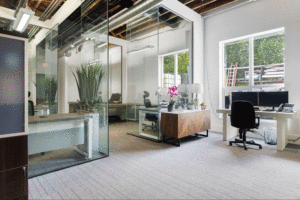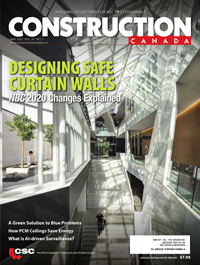Innovative materials for noise reduction in commercial spaces

Acoustic ceiling clouds
Modern commercial buildings are notably more open than their cubicle-centric predecessors. This can lead to some challenges regarding echo and unwanted noise transfer in sprawling interiors.
For years, buildings used a drop ceiling design to help reduce noise transfer in commercial interiors. Similar in concept to decoupling walls, a suspended drop ceiling hides the underlying structural ceiling, with sound waves being absorbed in the plenum space between the two.
While this approach works reasonably well for reducing noise transfer between building stories, it is not as effective at managing sound transfer on the same storey. To increase acoustic properties and add elements to a drop ceiling, modern acoustic ceiling clouds fit the bill.
Typically fabricated in the form of fabric-wrapped fibreglass (similar to wall acoustic panels), foam, perforated metal, or polyester, strategically-placed ceiling clouds can absorb up to 95 per cent of all the noise in a room, keeping conversations local in a sprawling interior while adding an element of architectural intrigue.
Glass partition walls
Despite the energy efficiency and customization upside of keeping commercial interiors open, there will be times when privacy is necessary. Acoustic panels and ceiling clouds can go a long way in preventing noise transfer, but they do not eliminate the chance of a random passerby overhearing parts of a private conversation or conference call.
For this purpose, custom glass partition walls are a great choice. They can be applied behind lobby counters, between office desks, or installed as complete floor-to-ceiling walls to create private meeting areas as necessary. These types of stylish glass partitions block and absorb sound while maintaining the bright, inviting ambiance of open commercial interiors. Thicker glass provides a higher sound transmission rating. Two layers of glass are often specified for rooms that require a sound transmission class (STC) rating higher than 36.
Flooring materials
When designing a commercial building, there are a few different kinds of noise to account for, and one of them is ambient airborne noise, which is noise transferred through the air (e.g. dogs barking, traffic blaring outside, professionals conversing, etc.). Ambient airborne noise is mitigated by adding mass and choosing sound-absorbing materials.
Impact-generated noise is created when the building’s mass receives some sort of impactful blow (e.g. footsteps, machine traffic, projectile debris, etc.), causing sound waves to “vibrate” and travel through the material. Impact-generated noise is largely an architectural concern and needs to be addressed during the design and construction processes. To this effect, the floor is a major architectural element that can either facilitate or diminish impact-generated noise, depending on the materials and design used.
Acoustic flooring can be a bit of a challenge in commercial spaces. The most durable flooring materials well-suited to withstand heavy use and abuse, such as polished concrete and epoxy terrazzo, are generally considered “loud” flooring materials and are susceptible to impact-generated noise and reflected sound waves. To enhance the sound insulation of these types of floors, there are some products, such as acoustic membranes, which are bonded to the surface before the finish is applied, to help absorb impact and limit sound wave transfer.
In multi-storey buildings, acoustic underlayment is added beneath hard floors to absorb noise transfer from lower levels. If the flooring is already in place and neither of these solutions are practical, strategically placing area rugs and rubber mats can add some noise-absorbing mass to the flooring surface.







